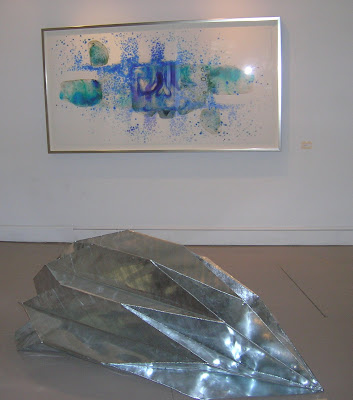Tuss on Weiss
Katie Tuss recently spoke with artist Ellyn Weiss at the Touchstone Gallery, where Weiss and fellow Touchstone artist Rima Schulkind are showing recent work in the main gallery space through June 3, 2007. Weiss’s Fortune Cookies series is comprised of 11 large panels and three sets of smaller panels, all brimming with striking colors and layers of additive and subtractive pigment, text, and ephemera.
Katie Tuss: You seem to be having a very busy spring with your current show at Touchstone, your involvement with Artomatic both as an artist and as a board member, and your role as an artist and curator for the current show No Representation at the Warehouse Gallery. As if this isn’t enough, what else do you have coming up?
Ellyn Weiss: It has been a very busy spring! All great, all fun experiences! Any time you can meet other people and see other people’s work, you have to do it. In June, I will also have 12 to 15 monoprints from my Time of War series in the back room at the Nevin Kelly Gallery. They are all one of a kind prints and use a reductive process. After June, my life is over!
KT: What was it like being on the curatorial side of No Representation?
EW: I had co-curated the Artomatic poster show at the Warehouse, but I was amazed by No Representation. We just got together and made lists of who we would love to have, paired it down and emailed everyone. I think everyone, except one person, was ready to participate. The show really demonstrates what’s happening in abstract art in DC, everyone really rose to the occasion. There are so many talented artists, we just need more people to buy.
KT: You have a JD from Boston University and previously practiced law. How did you come to be involved in the arts and specifically in the art scene in the DC area?
EW: I practiced law for 25 years, but I have always been involved in art. I made art on weekends, in the summer, and I took a lot of classes. I practiced law until I had enough money to quit and do this full time.
KT: How did quitting change things?
EW: Quitting and going full time was important. Art is like anything, the more you do it, the better you get. And things changed when I discovered these large 40 by 60 pieces of paper. The size allowed for my gestural movements. Then I discovered the pigment sticks—they have the consistency of butter. I don’t use brushes, haven’t used them in years. I found the pigment sticks on accident on R&F’s website.
KT: Your artist statement says that you admire art that speaks directly to the viewer without mediation or explanation. Do you think that art becomes more valid when the viewer understands the concepts behind the work, or should the visual experience speak for itself?
EW: I can not get myself interested in work that doesn’t capture me viscerally; if it doesn’t work in the first five seconds.
KT: Are you conscious of this when creating your own work?
EW: Yes. I’m conscious of the visceral as I work. Sometimes a work can get to a place that is seductive, yet unfinished, and I just keep going. It’s hard, but I know it can get better.
KT: Why is layering important? What do you learn about the paintings as you add and subtract?
EW: The paintings always start with words, words that have meaning. The letters inform the first shapes. The Fortune Cookie series is the first time I have used readable text.
KT: The Fortune Cookie series is bold and colorful, with wide marks and layers of mixed media, including hundreds of fortunes you have collected over the years printed on pattern paper and collaged into your paintings. In June, the Nevin Kelly Gallery will show some of your Time of War monoprints. These works seem very different. Are the two series or styles of work connected or influenced by the other?
EW: They are very different. The Time of War series comes from feeling frustrated with the war, with innocent people dying, people that we don’t even count. Michael Mazur, one of the founding spirits of the Fine Arts Work Center was teaching a print making workshop that I participated in and he said to do whatever moves you, and I started with wanting to use this reductive process, got into it, and he didn’t say anything to me for the week long duration of the workshop. At the end of the week, Mazur said that he wanted to talk to me. He told me that it was an impressive body of work and that he hadn’t said anything to me because he could tell I was so focused. The goal of the Time of War series was to convey strong emotion as simply as possible. They are dark, there isn’t a lot of happiness in that work. I don’t know if I will do it again.









